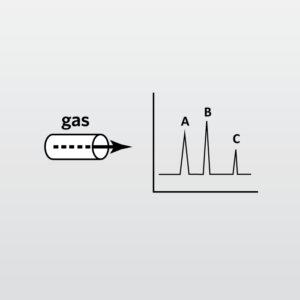Gas chromatography (GC)
Home » Our Techniques » Chromatography » GC
Gas Chromatography (GC) is an analytical tool used to identify and quantitate a wide variety of compounds in a mixture. GC utilizes a compound’s intrinsic affinity for a “stationary phase” (solid support with specialized coating) and facilitates the separation of complex sample matrices into their component parts.
Essentially, in Gas Chromatography, a sample is injected into the hot inlet of a gas chromatogram, which volatilizes the components in the sample. Next, an inert gas (“carrier gas”) carries the volatile compounds through a coated capillary column. The capillary coating or “stationary phase” is housed inside the capillary column. The flame ionization detector (FID) passes sample and “carrier gas” from the column through a hydrogen-air flame. The hydrogen-air flame alone creates few ions, but when an organic compound is burned, there is an increase in ions produced. A polarizing voltage attracts these ions to a collector located near the flame. The current produced is proportional to the amount of sample being burned.

This current is sensed by an electrometer, converted to digital form, and sent to a data system where a chromatogram is electronically constructed. The time it takes a specific compound to pass through the capillary column and to a detector is called its “retention time.” Retention time, which is inherently related to a compound’s affinity to the stationary phase, can be used to identify the compound in question when compared to a reference standard.
Ideal Uses of Gas Chromatography
- Quantitative volatile analysis
- Purity profile quantitation
- Residual solvents quantitation
- Medical device chemical characterization via ISO 10993:18
Strengths
- GC/FID is sensitive to virtually all compounds that contain hydrocarbons and that will burn; examples are aromatic and chlorinated VOCs, petroleum constituents, SVOCs and PCBs
Limitations
- Samples must either be volatile or capable of derivatization
- GC/FID is responsive to compounds with carbon-hydrogen bonds only
- GC/FID is a destructive technique so no additional analysis can occur on the sample after it is performed
- Identification and quantitation is limited to the compounds for which reference standards are run
GC Technical Specifications
- Detection limit “on column”:
- Approximately 1 ppm (Direct Injection)
- Approximately 10 ppb (Headspace Injection)
- Suitable operating temperature for chromatographic separations: 30-450°C
Would you like to learn more about using Gas chromatography (GC)?
Contact us today for your Gas chromatography (GC) needs. Please complete the form below to have an EAG expert contact you.